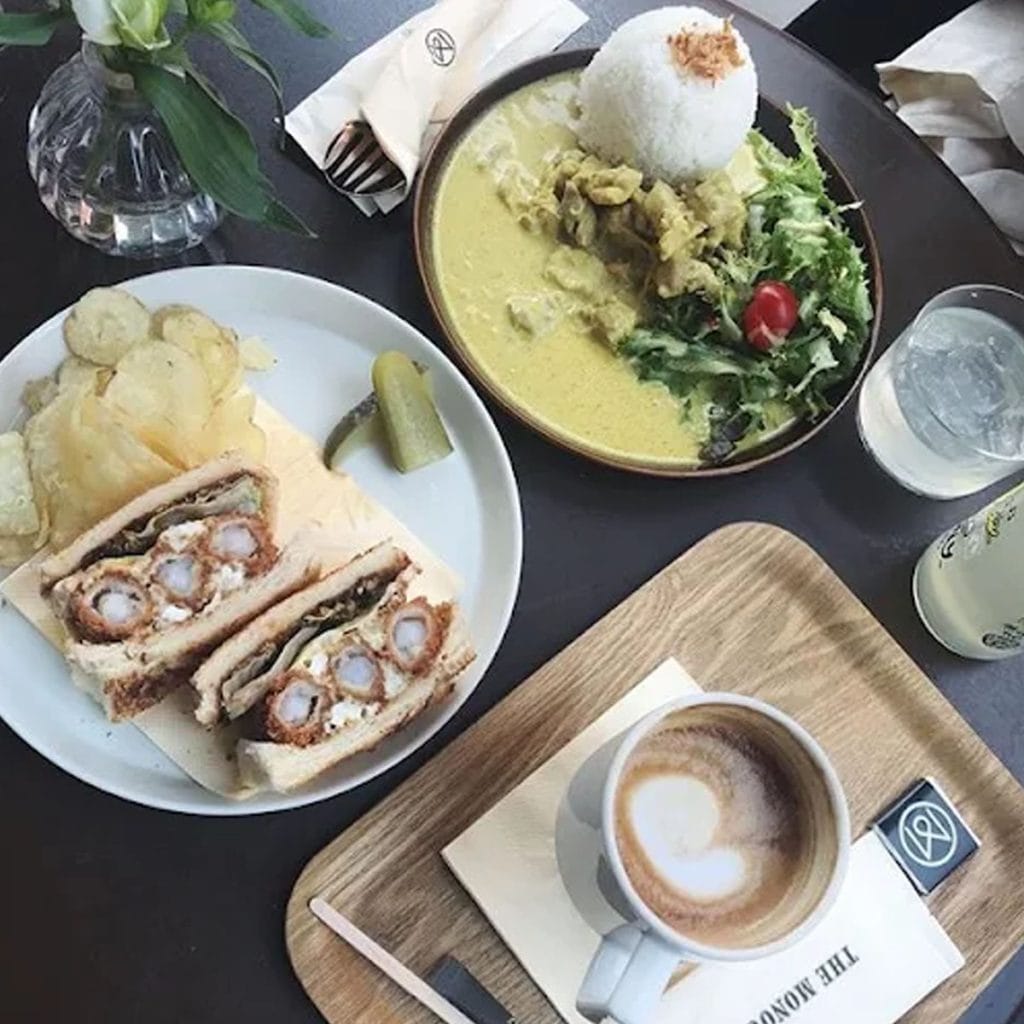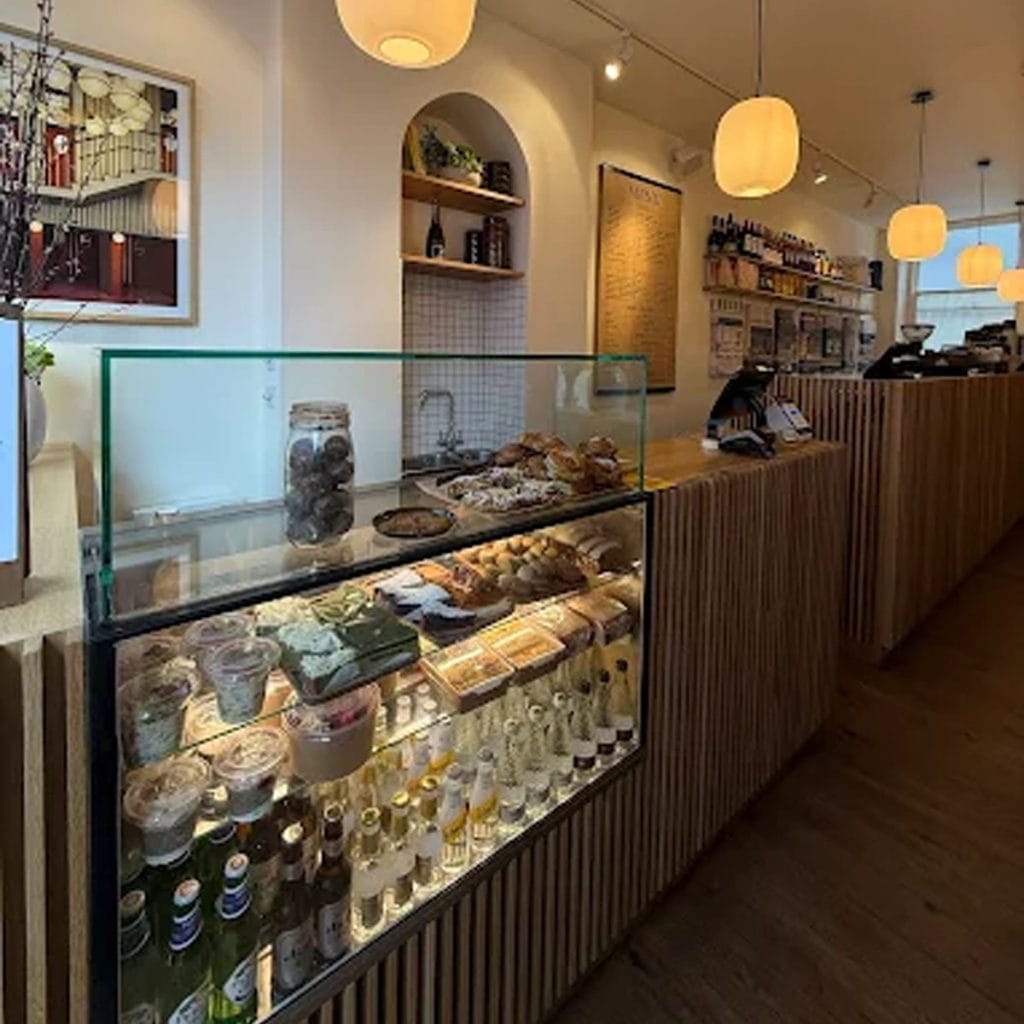Suppose you pause outside Chiltern Street on any crisp London morning. In that case, you will see a confident strip of black-and-white canvas staking its claim beside Georgian brickwork. A line of regulars idles beneath it, clutching reusable cups and folded copies of Monocle. They speak in brisk Italian, polished Japanese, and the clipped vowels of Marylebone locals, united by the quiet thrill of stepping into a living page of their favourite magazine. That short queue explains why this compact address has become shorthand for thoughtful coffee, print-first values and the sort of understated design that whispers rather than shouts.
From Magazine Page to Chiltern Street Table
Monocle, the magazine, debuted in February 2007, promising rigorous reportage seasoned with a taste for good architecture, dependable luggage and sharp tailoring. Six years later, those pages gained a postcode: 18 Chiltern Street opened on 15 April 2013, following a successful prototype inside Hankyu Men’s in Tokyo. Founder Tyler Brûlé chose the site with deliberation. Marylebone offered leafy calm, global footfall and a reputation for independent retailers that value craft over fashion. The café would translate ink on paper into steam, scent and conversation, creating a setting where readers could linger, network and—crucially—spend.
Brûlé’s vision rejected the traffic-chasing model of digital media. Instead, he backed a slower, deeper relationship with what he calls a “quality audience”. The café had to generate profit in its own right through carefully priced drinks, light meals and magazine sales. Still, it also played a longer branding game. Every flat white sipped under that awning nudged a visitor closer to a subscription, a retail purchase or a long-haul flight to one of the sister cafés in Tokyo or Zürich.
Tyler Brûlé and the Quality Audience Model
Brûlé earned design-world fame editing Wallpaper in the late 1990s, but Monocle broadened his scope to geopolitics, business and urbanism. Even so, the mantra stayed consistent: own your niche, serve it impeccably, and monetise across multiple touchpoints. The café embodies that strategy. Newspapers clipped to beech rods invite browsing; Monocle-branded chocolates arrive with each coffee; subscribers book the basement without charge. Revenue flows through hospitality, merchandise, consultancy workshops and advertiser events, yet the experience feels seamless to the customer.
Analysts often describe the place as a textbook “third space”, neither home nor office, yet the term undersells its reach. For itinerant architects flying in from Seoul, policy advisers pausing between Westminster meetings and style editors marching to showrooms, Monocle Café Marylebone doubles as an embassy, newsroom and clubhouse.
Design Leadership Without Noise
Yoshitsugu Takagi, head of Monocle’s in-house design studio, had to solve a puzzle familiar to central London operators: long on character, short on square footage. He answered with a marriage of Japanese precision and Nordic warmth. Slatted red-oak counters, gloss-white tiles and matte brass toggles establish a tactile hierarchy that calms the eye. Seating comes from Truck Furniture in Osaka; walls carry framed covers of the magazine’s most travel-hungry issues. The material honesty, solid timber, hand-thrown ceramics, and linen napkins mirror the editorial insistence on fact-checked reporting.
Illumination matters. Globe lights hang low enough to make laptop glare impossible, nudging guests toward conversation or quiet reading. During darker months, the room glows like a lantern from the pavement, tempting passers-by who had planned merely to cut through to Paddington Street gardens.
Fun Fact: The café’s house soundtrack, Monocle 24, broadcasts from studios beneath Midori House in Marylebone. If you hear the lunchtime news bulletin while ordering, the presenter is reading live just 300 metres away.
Street Presence and Social Signal
Unlike London’s neon-lit chain cafés, Monocle advertises through restraint. That striped awning and a discreet monochrome monogram signal confidence without clutter. Instagram amplified the effect: search the tag and you will find thousands of near-identical facade shots, each offering free brand exposure. The awning also functions as a navigational aid. Newcomers spot it from Dorset Street and adjust their stride, reassured that the address really is “just past Daunt Books and opposite Chiltern Firehouse”.
Two-Level Spatial Choreography
The ground floor seats barely ten, yet it works harder than cafés three times its size. Staff in pressed white jackets greet, prepare and pass off drinks in under three minutes, yet still remember regulars’ names. Standing room remains civilised thanks to slim counters that keep elbows tucked in. The soundtrack mixes soft jazz with city reports, enough murmur to mask business calls without forcing patrons to raise their voices.
Descend the narrow staircase and tempo shifts. Shoji-inspired paper lanterns throw a warm glow over leather banquettes; the scent of cedar hovers above fresh print. This quieter zone exists for reading, note-taking and strategy sessions. It can be reserved by subscribers, turning a magazine fee into an office-away-from-office benefit. The split personality solves an urban problem: commuters grab and go upstairs. At the same time, lingerers claim the calm below, each reinforcing the other’s sense of belonging.
Total Brand Immersion
Branding rarely feels this holistic. Magazine back issues line a waist-high shelf, arranged chronologically. Monocle Voyage candles burn near the till. Even the toilet tells a story: a Japanese TOTO washlet complete with illustrated instructions reaffirms the brand’s affection for Tokyo functionality. No surface escapes consideration; takeaway cups bear subtle co-branding with Allpress Espresso, and a slim business card lists sister outlets worldwide, encouraging the next pilgrimage.
Curated Menu Built on Travel, Not Trend
A menu can read like a manifesto, and Monocle’s does. Every dish traces a route sketched by the magazine’s editors on assignment. Coffee anchors proceedings through an exclusive partnership with Allpress Espresso. Flat whites settle into Japanese porcelain cups, maintaining temperature and pleasing weight in the hand. Matcha lattes, whisked to a glossy foam, pay homage to the café’s Tokyo roots and now dominate social feeds tagged Japanese cafés in London.
Tea comes from Postcard Teas, a few streets away, continuing the hyper-local sourcing. Cold drinks lean Nordic: sparkling lingonberry juice and Sana lemon soda from Norway sit beside London-brewed sodas flavoured with rhubarb and bay. The liquid offer alone makes the venue a reference point for Marylebone coffee shops that wish to appear worldly yet grounded.
Japanese Staples With Authentic Detail
Years before London’s sandwich boom embraced the concept, Monocle introduced the katsu sando to Chiltern Street. Panko-crusted chicken or shrimp meet pillowy shokupan bread, crisp cabbage and a wasabi-bright sauce, all sliced to neat rectangles. At eight-fifty pounds, it undercuts many trend-driven rivals while delivering sharper execution.
Morning visitors favour the Japanese Breakfast set: tuna-filled onigiri, sweet omelette, silken tofu with ginger and pickled cucumber. It arrives on a lacquer tray with ochre miso soup, creating a postcard of Tokyo precision that photographs as well as it tastes. Seasonal specials rotate through Okinawan taco rice, chilled udon and Japanese potato salad, demonstrating breadth without overloading the tiny kitchen.


Scandinavian Comforts on the Pastry Counter
The pastry case tilts north. Fabrique bakery, headquartered in Stockholm, provides fragrant cardamom buns whose sugar-flecked crust cracks to reveal buttery layers. Cinnamon rolls, almond croissants and spelt sourdough complete the savoury-sweet spectrum. Cakes arrive from Lanka, a Japanese-owned French patisserie on Finchley Road. Their matcha roll, layered with white-chocolate cream, has become a signature slice and a magnet for dessert aficionados. Pair it with the café’s filter-brew programme and you understand why repeat visits form quickly into weekly rituals.
Who Sits at These Tables
Talk to the staff, and a pattern emerges. Mornings draw architects, designers and tech founders comparing notebooks. Mid-afternoon welcomes graduate students scanning global affairs articles between lectures. Evenings sparkle with visiting diplomats and art buyers swapping tips before walking to nearby galleries. Many are Monocle converts already; others stumble in and leave as ambassadors. Regulars greet each other by first name, reinforcing a sense of low-key exclusivity that money alone cannot buy.
The café’s global diaspora extends through Monocle’s network. A business traveller who enjoyed a flat white here is likely to find the same cup profile in Zürich’s Seefeld branch next month. Consistency nurtures trust, turning the brand into a portable comfort object for the internationally mobile.
Chiltern Street Context and Neighbourhood Map
Chiltern Street’s renaissance began in the early 2010s when independent fashion, grooming and lifestyle labels replaced sleepy wholesalers. Today, the strip offers a considered itinerary. Start with coffee at Monocle, browse spines at Daunt Books Marylebone, select merino basics at Sunspel, fit Japanese denim at Bryceland’s and queue for cocktails at Chiltern Firehouse. Each business champions quality, personal service and timeless design, amplifying Monocle’s message by osmosis.
For visitors short on time, the magazine’s own shop at 34 Chiltern Street offers a shortcut. Travel guides, Porter luggage, collaborative knitwear and limited-edition prints sit metres from where the ideas were first discussed over espresso. The micro-district embodies Brûlé’s conviction that print, retail and hospitality can harmonise without hierarchy.
Staying Relevant in 2025
Longevity in London hospitality demands agility. Rather than chasing novelty, Monocle doubles down on editorial credibility. In January 2025, the brand staged a Reading Room pop-up with Italian restaurant Luca, offering complimentary coffee and unplugged browsing to promote slow consumption of media. The event echoed the café’s mission and pushed regulars toward a partner venue aligned in ethos.
Operationally, standards remain high. The Food Standards Agency inspected the café on 31 July 2024 and rated hygienic food handling “generally satisfactory” with facilities judged “good”. Transparency about such metrics sustains public confidence and pre-empts the rumour mill that can swirl around fashionable addresses.
Practical Tips and Visitor Key Facts
- Opening hours fluctuate; current consensus lists 07:00-18:00 on weekdays and 09:00-18:00 at weekends. Busy periods peak 08:30-10:00 and 13:00-14:00.
- Reservations are not accepted; arrive early for basement seats.
- Wi-Fi is intentionally slowed during lunch to encourage conversation.
- Vegetarian options include matcha granola, miso-glazed aubergine sando and seasonal salads.
- Accessibility: one step at the entrance; the basement is reached via a narrow staircase.
Before attending, verify details on the café’s official channels, as policies adapt to seasonal demand.
See our guide to other Marylebone coffee shops for alternatives if the queue stretches past Tracksmith.
Why It Matters for Marylebone
The Monocle Café illustrates how a print publication can translate values into architecture, aroma and community. By refusing to compromise on scale, ingredient quality or design integrity, it safeguards a pocket of thoughtful hospitality in a market prone to quick roll-outs. Local residents gain a meeting point, global visitors gain a compass, and Marylebone gains a permanent ambassador for curated living.

